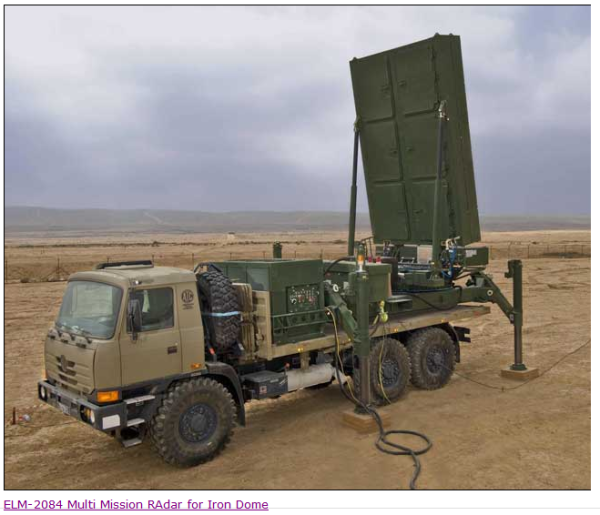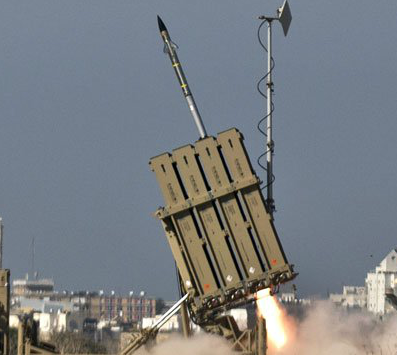This post collects what information I have been able to find on the characteristics of the Iron Dome system. Some of the details are of uncertain reliability. Previous posts (November 29, July 19) discussed what is known about Iron Dome’s effectiveness.
An Iron Dome Battery consists of a radar, a fire control center, and several, typically three or more, launchers. Each launcher is capable of holding up to 20 Tamir interceptor missiles. Each battery reportedly costs about $50 million.
The Iron Dome Radar. (Photograph from : http://www.iai.co.il/34380-en/CompanyInfo-Gallery-Radars.aspx)
ELM-2084 Radar
The Iron Dome Radar is a version of the ELM-2084 Multi-Mission Radar (MMR) radar manufactured by Israeli company ELTA Systems, a subsidiary of Israeli Aerospace Industries (IAI). The MMR is designed to detect and track artillery shells, rockets and missiles, as well as aircraft, and to support defenses against all of these. It is also able to quickly both estimate launch points and predict impact points of artillery shells, rockets and missiles, information which is useful for both warning and missile defense, as well as for attacking launchers.
The ELM-2084 is an active-array (that is, it uses many transmit/receive modules on its antenna instead of a single central transmitter) phased-array radar that operates in S-Band (between 2 and 4 GHz). The radar antenna is scalable (that is, it can be built in different sizes), as illustrated below in photographs (and a table) from a June 2010 Israel Aerospace Industries fact sheet. [1] An early version of the MMR reportedly was first used in support of Israeli military operations in the Gaza Strip in December 2008 to January 2009. There are currently at least three different versions of the MMR.[2] According to a February 2011 IAI press release, “dozens” of MMRs with a total value exceeding $500 million have been sold, including sales to foreign countries.[3]
ELM-2084 radars and Iron Dome Table #1 (Source: http://www.iai.co.il/sip_storage/FILES/9/38029.pdf)
The table below is from a somewhat earlier (January 2009) IAI Factsheet:[4]
Iron Dome Table #2
The two tables above indicate that the version of the MMR used in the Iron Dome system has a range of “up to” 100 km against artillery shells and other small (low radar cross section) targets and a range of up to 350 km against larger aircraft targets. They also suggest that it can estimate lauch points for artillery (including rockets) to within about 125 meters for 50 km ranges [0.25% of 50 km =125 m].
Tamir Interceptor
Iron Dome’s Tamir interceptor missile is described as being 3 m long, 16 cm in diameter and as having a mass of 90 kg.[5] The interceptor is said to have a maximum speed of Mach 2.2 (700 m/sec), with minimum and maximum ranges of 4 and 17 km, respectively. The missile, which operates within the atmosphere and maneuvers using fins and body lift, receives guidance command from Iron Dome’s control center until it is close enough to its target to home in on it using a radar seeker on the missile itself. A proximity-fused explosive warhead, triggered by an active laser fuze, is then used to destroy the target. The warhead mass is reported to be 11 kg.
To get a higher probability of kill two interceptors, separated by a short-time delay, can be fired at the same target. (I have not seen any estimate on what fractions of the engagements have used two interceptors.) The interceptors are typically described as costing about $50,000 each, although costs ranging from $30,000 to $100,000 each have been cited.
A Tamir interceptor leaves its launcher. (Picture source: http://www.bbc.co.uk/news/magazine-20397891).
At an exhibition in Israel in late 2010, Rafael, the manufacturer of the Tamir missile, displayed a ground-attack version of the Tamir called the “Iron Flame.”[6] This missile would eliminate the Tamir missile’s seeker and fuze, although it would retain the capability to receive guidance updates in flight, and could instead be equipped with several different types of warheads and seekers. It is unclear (to me) if this missile has ever been produced or deployed.
System Capability
The baseline Iron Dome system is said to be able to counter rockets and artillery shells with ranges of between about 4 and 70 km, and can also be used against aircraft. Against rockets with a range of 15 km, Iron Dome is said to be able to defend an area of about 150 km2 (about 60 square miles), with the size of the defended area increasing as the range of the attacking rockets increases.
Four Iron Dome batteries were deployed at the beginning of the November 2012 rocket attacks. A fifth battery was deployed on November 17 near Tel Aviv. This battery was to be the first of a second group of four batteries with some improved features, including the ability to intercept longer-range missiles.
A total of 13-15 Iron Dome batteries are generally described as being the number needed to cover major populated areas in Israel.
[1] AIA-ELTA, “Multi-Mission Radar (MMR) Family – ELM-2084,” available at: www.iai.co.il/sip_storage/FILES/9/38029.pdf.
[2]IAI Press Release, “IAI Awarded Multiple Orders Worth Hundreds of Millions of Dollars to Supply its New-Mission Radar,” June 10, 2009. Available at: http://www.iai.co.il/35063-39658-en/default.aspx. This press release announced the sale of a total of 34 radars.
[3] IAI Press Release, “Advanced versions of IAI’s Multi Mission Radar Fielded Successfully,” February 8, 2011. Available at: http://www.iai.co.il/35704-41938-en/AeroIndia2011_Homepage_News.aspx.
[4] IAI, “Multi Mission Radar (MMR) – EL/M-2084,” January 2009. This no longer appears to be available on the IAI’s website, but is available at: http://www.slideshare.net/hossamzein/missile-guidance-systems.
[5] IHS Jane’s, “Iron Dome (Iron Cap),” May 10, 2012; “IRON DOME Defense System Against Short Range Artillery Rockets,” ArmyRecognition.com, available at: (http://www.armyrecognition.com/israel_israeli_military_missile_vehicles_systems_u/iron_dome_defense_system_against_short_
range_artillery_rockets_technical_data_sheet_specifications.html#description)
[6] Noam Eshel, “Rafael Plans Extending Iron Dome Capability to Precision Surface/Surface Attack,” Ares Blog, Aviationweek.com, November 11, 2010 (available at: http://www.aviationweek.com/Blogs.aspx?plckBlogId=Blog:27ec4a53-dcc8-42d0-bd3a-01329aef79a7&plckController=Blog&plckScript=blogScript&plckElementId=blogDest&plckBlogPage=BlogViewPost&plckPostId
=Blog:27ec4a53-dcc8-42d0-bd3a-01329aef79a7Post:7e4d03fc-80e7-4bf0-a6c0-8270e72698d1); Tamir Eshel, “Israel Delays Deployment of Iron Dome,” defenseupdate.com, November 10, 2010 (available at: http://defense-update.com/20101110_iron_dome_delay.html); and “Enhanced Air Defense Missile,” Defense Technology International, March 1, 2011.




Allen Thomson
/ December 5, 2012A slightly random question: Would Iron Dome be an effective defense against gravity bombs, particularly guided ones like JDAM, Paveway etc. ?
mostlymissiledefense
/ December 6, 2012Allen, A very interesting question.
I don’t know the answer for sure, but I would guess that a falling gravity bomb would at least in principle be a fairly easy target if it was within range. The radar cross section of a bomb is likely comparable to or larger than that of an artillery shell, and like the artillery shell it is on a ballistic trajectory (leaving aside air resistance). Possibly the existing Iron Dome system is programmed to ignore objects falling vertically, since a typical such object would be falling debris from an earlier intercept. A guided weapon, which might be gliding and/or otherwise maneuvering, could be a more challenging target, both to predict the intercept point and then to actually hit the target if it maneuvers just before the intercept.
So my guess would be yes, it likely could, if it was programmed to enable such intercepts. Of course, the airplane dropping the bomb or guiding the weapon might be the easier target.
George Lewis
Ryan Crierie
/ January 29, 2013IRON FLAME sounds very interesting. Eliminating the expensive seeker and fuze would be a significant cost reduction in the price of an IRON DOME interceptor missile — all the expensive parts would now be on the ground and re-usable for multiple intercepts. The same basic principle was used for the NIKE series of missiles all the way up to SPARTAN.
Allen Thomson
/ January 29, 2013Since this thread still seems to be alive, another question: Would Iron Dome/Flame be useful for South Korea to have if it needed to defend against the DPRK’s fabled zillions of artillery tubes? Selective defense against incoming rounds plus counter-battery targeting sounds attractive.